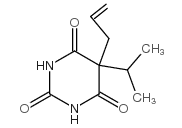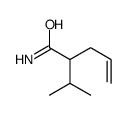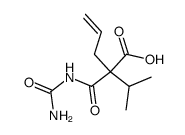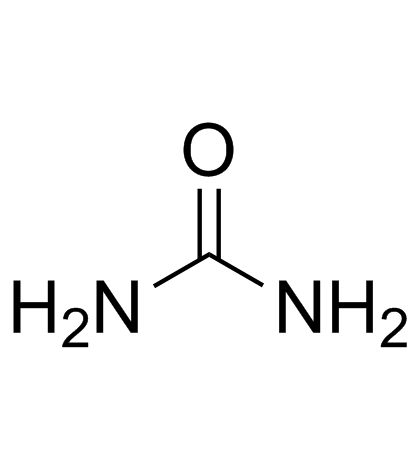Apronal
Modify Date: 2024-01-06 18:25:06
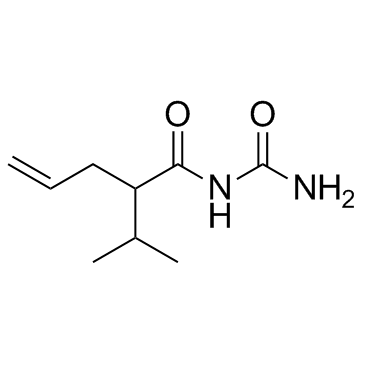
Apronal structure
|
Common Name | Apronal | ||
|---|---|---|---|---|
| CAS Number | 528-92-7 | Molecular Weight | 184.23600 | |
| Density | 1.025g/cm3 | Boiling Point | N/A | |
| Molecular Formula | C9H16N2O2 | Melting Point | 196 °C | |
| MSDS | N/A | Flash Point | N/A | |
Use of ApronalApronal (Allylisopropylacetylurea, Apronalide) is a hypnotic and sedative drug that has been withdrawn in several countries due to side effects. |
| Name | N-carbamoyl-2-propan-2-ylpent-4-enamide |
|---|---|
| Synonym | More Synonyms |
| Description | Apronal (Allylisopropylacetylurea, Apronalide) is a hypnotic and sedative drug that has been withdrawn in several countries due to side effects. |
|---|---|
| Related Catalog | |
| In Vivo | Research shows that allylisopropylacetylurea not only increases the amount of porphyrins in the liver and urine of animals but also brings about a marked green pigmentation of the liver. Rats recover well from long-term treatment with high doses of allylisopropylacetylurea and revert to normal values for parameters measured. Lesions originated by long-term administration with allylisopropylacetylurea can be tolerated by rats and are reversible[1]. Fixed drug eruption and mucocutaneous ocular syndrome are reported due to apronal[2]. |
| Animal Admin | Rats: Apronal is administered to male Sandoz OFA-SPF rats, weighing 140-150 g in two equal daily subcutaneous injections 8 h apart. The overall daily dose is 400 mg/kg and dosing is continued for 21 days. Control rats are similarly treated with propandiol only. Urine samples are collected in glass tubes at solid CO2, temperatures and stored frozen until analysis[1]. |
| References |
| Density | 1.025g/cm3 |
|---|---|
| Melting Point | 196 °C |
| Molecular Formula | C9H16N2O2 |
| Molecular Weight | 184.23600 |
| Exact Mass | 184.12100 |
| PSA | 72.19000 |
| LogP | 2.12080 |
| Index of Refraction | 1.474 |
CHEMICAL IDENTIFICATION
HEALTH HAZARD DATAACUTE TOXICITY DATA
|
| HS Code | 2924210090 |
|---|
|
~% 
Apronal CAS#:528-92-7 |
| Literature: Hoffmann-La Roche Patent: DE459903 ; Fortschr. Teerfarbenfabr. Verw. Industriezweige, vol. 15, p. 1478 |
|
~% 
Apronal CAS#:528-92-7 |
| Literature: Riedel,J.D. Patent: DE461814 ; Fortschr. Teerfarbenfabr. Verw. Industriezweige, vol. 16, p. 2476 |
|
~% 
Apronal CAS#:528-92-7 |
| Literature: Aspelund; Skoglund Acta Academiae Aboensis, Series B: Mathematica et Physica, 1937 , vol. 10, # 10 p. 8,15,19,22 Chem. Zentralbl., 1937 , vol. 108, # II p. 2004 |
|
~% 
Apronal CAS#:528-92-7 |
| Literature: Riedel,J.D. Patent: DE461814 ; Fortschr. Teerfarbenfabr. Verw. Industriezweige, vol. 16, p. 2476 |
| HS Code | 2924210090 |
|---|---|
| Summary | 2924210090 other ureines and their derivatives; salts thereof VAT:17.0% Tax rebate rate:9.0% Supervision conditions:none MFN tariff:6.5% General tariff:30.0% |
| APRONALIDE |
| Allylisopropylacetylurea |
| Sedormid |
| Allylisopropylacetylcarbamide |
| Isopropylallylessigsaeure-ureid |
| (2-Isopropyl-4-pentenoyl)urea |
| 2-Isopropyl-pent-4-ensaeure-ureid |
| Allylisoprorylacetylurea |
| EINECS 208-443-3 |
| Apronal |
| Isodormid |
